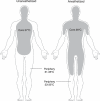Unintended perioperative hypothermia
Abstract
Background: Hypothermia, defined as a core body temperature less than 36°C (96.8°F), is a relatively common occurrence in the unwarmed surgical patient. A mild degree of perioperative hypothermia can be associated with significant morbidity and mortality. A threefold increase in the frequency of surgical site infections is reported in colorectal surgery patients who experience perioperative hypothermia. As part of the Surgical Care Improvement Project, guidelines aim to decrease the incidence of this complication.
Methods: We review the physiology of temperature regulation, mechanisms of hypothermia, effects of anesthetics on thermoregulation, and consequences of hypothermia and summarize recent recommendations for maintaining perioperative normothermia.
Results: Evidence suggests that prewarming for a minimum of 30 minutes may reduce the risk of subsequent hypothermia.
Conclusions: Monitoring of body temperature and avoidance of unintended perioperative hypothermia through active and passive warming measures are the keys to preventing its complications.
Keywords: Hypothermia; perioperative; prewarming; thermoregulation.
Figures




References
-
- Morris RH. Operating room temperature and the anesthetized, paralyzed patient. Arch Surg. 1971;102(2):95–97. - PubMed
-
- Kurz A. Physiology of thermoregulation. Best Pract Res Clin Anaesthesiol. 2008;22(4):627–644. - PubMed
-
- Kurz A, Sessler DI, Lenhardt R. Perioperative normothermia to reduce the incidence of surgical-wound infection and shorten hospitalization. Study of Wound Infection and Temperature Group. N Engl J Med. 1996;334(19):1209–1215. - PubMed
-
- Frank SM, Fleisher LA, Breslow MJ, et al. Perioperative maintenance of normothermia reduces the incidence of morbid cardiac events. A randomized clinical trial. JAMA. 1997;277(14):1127–1134. - PubMed
-
- Luna GK, Maier RV, Pavlin EG, Anardi D, Copass MK, Oreskovich MR. Incidence and effect of hypothermia in seriously injured patients. J Trauma. 1987;27(9):1014–1018. - PubMed
LinkOut - more resources
Full Text Sources
Other Literature Sources
Medical
Research Materials
